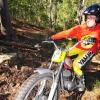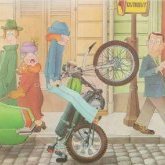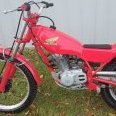-
Posts
3,960 -
Joined
-
Last visited
-
I saw a XISPA being ridden in a trial when they were first imported into Australia, by a person who I think was the importer. I'm thinking it was about 2010.
-
You can usually lean bikes on their side to work on the clutch without draining the oil
-
Model 159 is a 325 Sherpa T from the mid 1970s. Where located? Does it run? When was it last run? What is its riding/maintenance/rebuild history? Front tyre looks like a 1970s Pirelli. Shocks look like original style Betors. These things make it look like it might have sat unused somewhere for a long time
-
feetupfun started following Bultaco Engine Numbers
-
The only 326cc Alpina is the model 99. All the later "350" Alpinas were 348cc. Model 116 is the next "350" Alpina model after the model 99.
-
If you're worried and want to check it out, measure what temperature it is running at. A thermal camera is great for this. If the cooling fan duty cycle is more than about 50%, then I would be checking coolant level, restrictions to airflow through the radiator and if the fan is running the right direction.
-
Your photo of the inverted carburetor shows that you have omitted to fit a gasket/copper washer under the float valve seat/body. This omission is a possible cause for the float bowl overflowing
-
In late 2023, I investigated a hot running issue with a friend's low hours 2022 TRS 300. It ran poorly when trail-ridden once warmed up. I found some things wrong. 1 the coolant level was very low. From memory it took something like 300 ml to get the level up where the book says. 2. The fuel filter inside the fuel tank was restricted by debris. 3. There was way too much sooty carbon on the piston crown and inside the head for the hours it had run. 4. I found something that I don't know is wrong or not, but seemed odd to me. It had both a resistor spark plug and a resistor spark plug cap. 5. The reeds had wear marks from touching the open stops. I found out that the owner had been using Castrol 747 premix oil (the one with some castor oil in it). I de-coked it. I cleared the fuel flow restriction. I fitted a non-resistor spark plug. The owner then ran it on semi-synthetic premix oil. It ran fine. The reeds are going to be replaced soon. I suspect the running issue was being caused by the engine running hot due to lack of coolant, float bowl level going low due to fuel filter restricted and too-high compression ratio due to carbon build-up.
-
For flat turns, lean it over. Counterbalance the bike weight with your body so you can ride very slowly. Try it stationary to start with. This trains your brain. Control speed in the turn using the rear brake working against steady throttle. If you want to learn to do turns with the front tyre off the ground, one way is to practice turning slowly on steeper and steeper slopes (going up to going down turns). This gets you accustomed to riding turns with little/no weight on the front tyre.
-
Looks like they have a heel
-
The lack of kickstart train parts for this bike and the other Montesa models based on the Cota 123 (Cota 172/200/242) is well known. There have been batches of suitable parts made in different parts of the world over the years, usually by individuals who needed parts and had a batch made (France, Australia....) and sold off the rest. I haven't heard of anyone doing this recently. I wouldn't expect that the usual commercial suppliers would carry these parts for such a small market.
-
My laptop opens the site but my AVG virus protection produces a warning each time I open Trials Central. The warning message is "Dangerous webpage. Threat category: URL blacklist" The Trials Central page continues to work normally apart from this AVG warning message
-
Here are photos of a TY250 head to show the cast-in boss that mcman56 is referring to.
-
Standard TY250 twinshock head has a single central plug hole. None of the TY250 twinshock heads came standard with a decompressor or a hole for one. The first series of 434 TY250 cylinder has a boss on the front of the cylinder that would allow the use of the type of decompressor that Yamaha fitted to some bikes, that opens a small hole between the cylinder wall above the exhaust post into the exhaust duct. There are plenty of other 250 Yamahas that have a head that will fit on the TY250 cylinder and have two plug holes. The bike your head came from could probably be identified using photos of the head. Aftermarket Yamaha heads in the 1970s were made to look spectacularly different to OEM Yamaha heads in a bid to make it obvious visually that they are aftermarket.
-
The frame stamping is for model 199 not model 199A. The bike in the photo does resemble a 199A but may be a modified 199.
-
As well as the gasket thickness, the new float may be slightly different shaped, causing the tickler to miss it. I had the same issue with the tickler not pushing the float down on the same carby. I didn't pursue a solution because I didn't like the carby anyway and fitted an OKO









